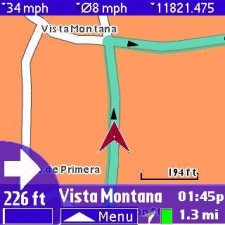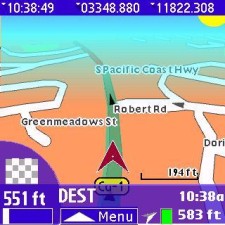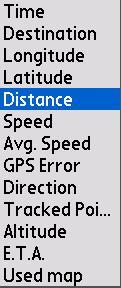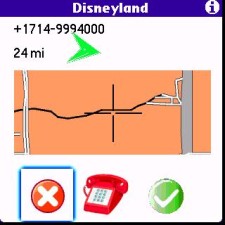User Opinions
|
||||||||||
|
|
|
| Wed Nov 15, 2006 - 10:56 AM EST - By Harv Laser | |
|
|
|
|
|||||||||||
The EMTAC Navigator software does a decent job of utilizing the small screen of the Treo. Typically, when using the Treo as a GPS device, you'll have it mounted in some kind of cradle suction cupped to your windshield or clipped to your a/c vents, but it's still a 2" screen a couple feet away from your face, so clarity and graphical layout you can quickly eyeball while driving are of paramount importance.
Sure, an in-dash factory GPS system in newer cars has a much bigger screen. But those systems aren't portable, and they're still a $2000-$3000 option on new cars which is why most new car buyers don't opt to pay for them. They too can be hellatiously complicated to learn. Just for grins, I took a look at the online PDF manual for a top-line Infiniti's GPS system � 175 pages of instructions!
As you drive, the EMTAC software clearly shows the direction of and distance to the next turn. A distance bar also gets shorter as you get closer to your turn. The name of the street for your next turn is in a big clean font at the bottom of the screen. In the lower right you'll see the E.T.A., compass heading, GPS status, and total distance to the destination, and you can view the route you're driving in either a straight down "paper map" 2D view, or a very pretty tiltable 3D view.


You can tweak and customize EMTAC's interface to suit almost anyone�s personal preferences (but please don't do it in heavy traffic!). Everything from the route, background, directions, even the POI�s (points of interest) can be customized with almost any color you'd like.

By enabling the upper status bar, you can also display any three of the following parameters: time, destination, longitude, latitude, distance to destination, speed, average speed, GPS error, direction (in degrees), altitude, ETA and map used. These three indicators, though, are pretty small, and again, on a 2" screen a couple feet from my face, I often had to lean towards the Treo to read them.
Road preferences can also be customized with a slider bar. Move the slider to the right and highways will be used more than city streets. The road selection starts at highways and there is a slider all the way down to alleyways (6th level streets).
As noted, the EMTAC software can route to thousands of Points of Interest, favorites, history (places you've told it to route to before), as well as contacts from the Palm address book.
All of the routing options work well and are easy to use except for the address book. This is by FAR the software's biggest disappointment. To put it politely, I'd say that it has lots of �hiccups�. If I felt less tactful, I'd just say it's broken.
When you tap on "address book" a list of your Treo's Contacts pops up, assuming you already stored some folks' address. The EMTAC software accesses the Palm contact database so if you have abbreviated any address, added apartment numbers, have anything misspelled, or any other notes the software MAY not understand the entry and not route you to the contact. This was VERY frustrating as whenever I tried to route to a contact, I never knew if it would work. When it didn't, I was faced with a blank window with no options other than tapping on a red �X� to go back.
In my discussions with Transplant GPS about this glitch, apparently the software, which was coded in Europe, is extremely picky about how a contact's address is parsed. For example, how many ways can you enter the word "Street"? Well, Street, street, ST., St., st., st, and maybe some other ways I can't think of. Or the same for the words Avenue, Boulevard, Highway, Road, Court, Crescent, Circle.. you get the idea. The software understands some abbreviations, and not others. Its algorithms for accepting road name variants needs a lot of work and it's totally hit or miss as to which contacts' addresses it'll accept and route you to, and which it won't. I sure couldn't figure out any pattern to what it liked or didn't like.
They should fix this or rip it out because far less than a third of my contacts worked. I'd rather see them fix it. The ability to scroll through your contacts and say "route me there" is sexy and appealing, never mind tremendously handy. But it simply doesn't work correctly in this otherwise lovely program.

The points of interest database is huge and features the expected classics like airports, hotels, restaurants, etc. It also has unique POI�s such as border crossings, bowling alleys, and wineries. You can choose to route to a nearby point of interest by tapping on "POI(Pos)", for Point of Interest Position. If you want to route to POIs in a certain town, tap on "POI(Dest)", for "point of interest - destination." Let's say you want to find amusement parks in Anaheim, CA. Go to the "select destination" screen, type Anaheim, then tap the green check mark. You'll get the list of POI�s. Choose �Amusement Park� and over 15 results pop up by name.
Another really helpful tool is the ability to make a call to the POI directly from the Treo.
Select the POI from the list, then tap on the map icon and you will be given the phone number (and option to call) as well as the distance to the POI. Other destination options include routing to user defined favorites, also known as waypoints, as well as recently used addresses.
Bundled with the software is a beautiful little second generation receiver from the inventors of the Bluetooth GPS, the S3-BTGPS. As mentioned, it uses the latest SiRF Star III GPS chipset and has an internal battery good for nine hours of constant use. The stealthy black receiver has three LED�s which represent Bluetooth (blue), GPS (green), and charging (red/orange). Attaining a GPS fix out of the box took a little less than a minute from a "cold" start, but mere seconds from a "warm" or "hot" start, and was indicated by the Green (middle) LED flashing.
Even under the drivers� seat, in your pocket or in the glove box, this unit still had enough lock on the GPS satellites to keep the software routing me without any problems. I even got it to get a satellite lock indoors with the drapes closed, 10 feet from the nearest window. SiRF Star III kicks butt!
There's NO need to mount the receiver on top of your dash. It doesn't have to "see" the sky. This receiver is fully NMEA compliant, which means it can be used with virtually any other Bluetooth-aware GPS software out there. There are GPS applications available for PalmOS that feature topographic, marine charting, and even aviation software, so you're in no way locked into using only EMTAC Navigator with it.
Copyright 1999-2016 TreoCentral. All rights reserved :
Terms of Use : Privacy Policy
TREO and TreoCentral are trademarks or registered trademarks of palm, Inc. in the United States and other countries;
the TreoCentral mark and domain name are used under license from palm, Inc.
The views expressed on this website are solely those of the proprietor, or
contributors to the site, and do not necessarily reflect the views of palm, Inc.
Read Merciful by Casey Adolfsson